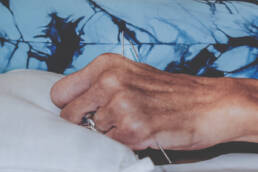Physiological Barriers
Physiological barriers are limitations caused by a person’s health condition or disability, such as hearing loss, illness, or SCI. Despite motivation and interest in being exercise active, individuals with SCI face many obstacles.
Limited Regenerative Capacity
Unlike other tissues in the body, the spinal cord has limited capacity to regenerate following injury. The nerve fibers in the spinal cord are surrounded by myelin, which inhibits regeneration, making it difficult for damaged nerve fibers to regrow.
Inflammation & Scar Formation:
After a spinal cord injury, the body’s immune system responds with an inflammatory response, which can lead to the formation of scar tissue. Scar tissue can create a physical barrier that blocks axon growth and inhibits regeneration.
Blood-Brain Barrier
The blood-brain barrier can be a barrier to drug delivery and may limit the efficacy of certain treatments for SCI. This barrier is designed to protect the brain and spinal cord from foreign substances, but it can also limit the delivery of drugs and other therapies to the injured area.
Neuroplasticity
The spinal cord is capable of some degree of neuroplasticity, which allows for rewiring of the nervous system after an injury. However, the extent of neuroplasticity is limited, and it can be difficult to achieve functional recovery following a severe SCI.
Secondary Injury
After an initial SCI, there is a risk of secondary injury, which can further damage the spinal cord and lead to additional functional impairments. This can be caused by a variety of factors, including inflammation, ischemia, and excitotoxicity.
Heterogeneity of Injuries
Spinal cord injuries can vary widely in severity, location, and mechanism of injury, making it challenging to develop a “one-size-fits-all” treatment approach. The best treatment for one patient may not be the best treatment for another, and individualized care plans must be developed based on the specific needs and circumstances of each patient.
Consequences of a spinal cord injury entail much more than damage to the spinal cord.
Understanding these physiological barriers is essential for developing effective treatments for SCI.
While progress has been made in the field of SCI research, there is still much work to be done to overcome these obstacles and improve outcomes for individuals living with spinal cord injury.
Take the Next Step Toward Recovery
Whether you’re just beginning your journey or looking for new ways to push forward, NeuAbility is here to help. Contact us today or explore our programs to see how we can support your path to greater independence, strength, and community.
Like this article? Spread the word!
Related Posts
May 9, 2025
Activity-Based Therapy for Paralysis: Building Strength, Independence, and Community
Learn how activity-based therapy (ABT) helps individuals with paralysis improve motor…
May 9, 2025
6 Powerful Ways to Boost Neuroplasticity for Brain Recovery and Function
Explore six proven ways to enhance neuroplasticity—including exercise, brain stimulation,…
May 9, 2025
The Benefits of Functional Electric Stimulation (FES) for Individuals with Paralysis
Learn how Functional Electric Stimulation (FES) helps individuals with paralysis by…





